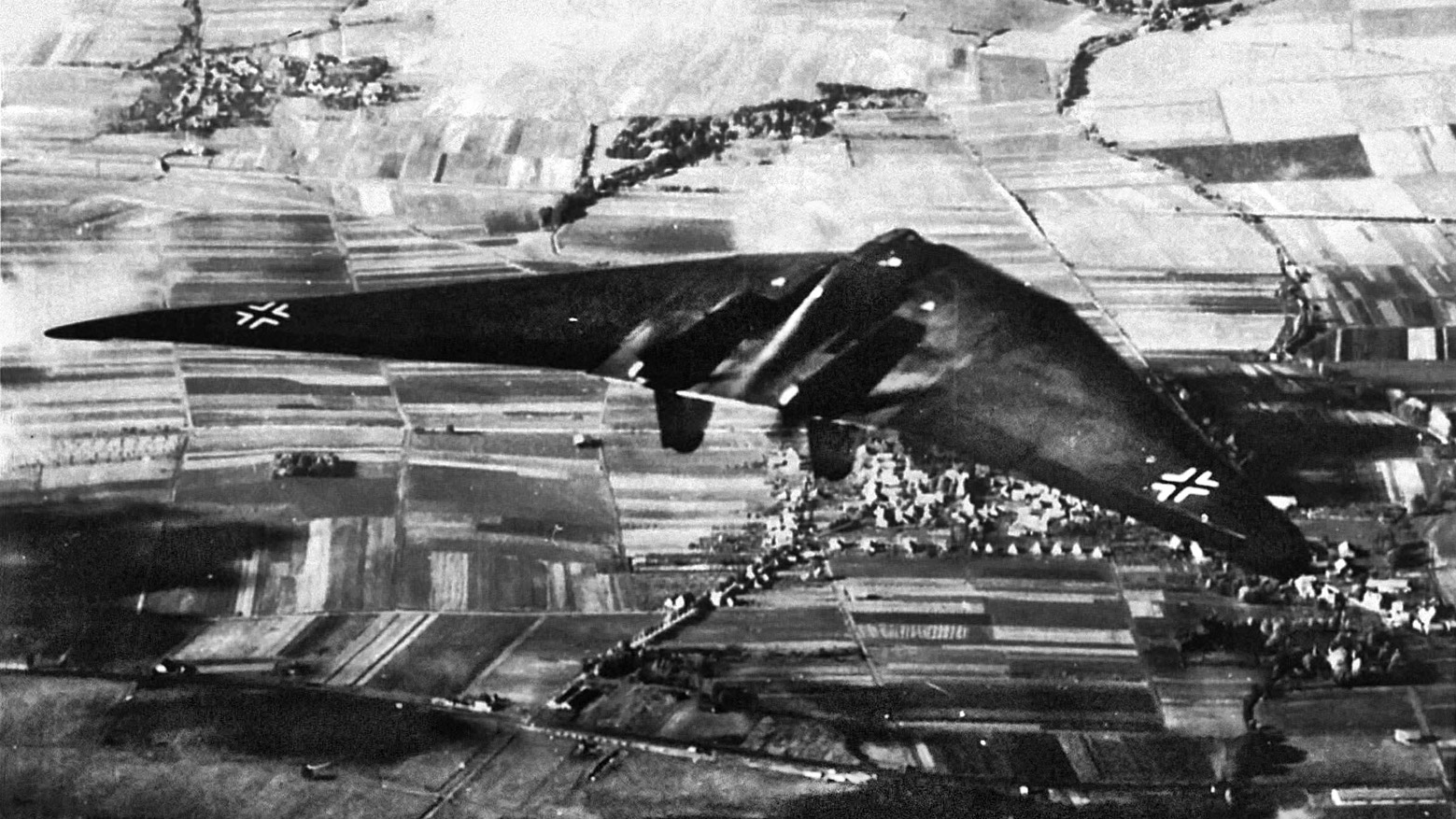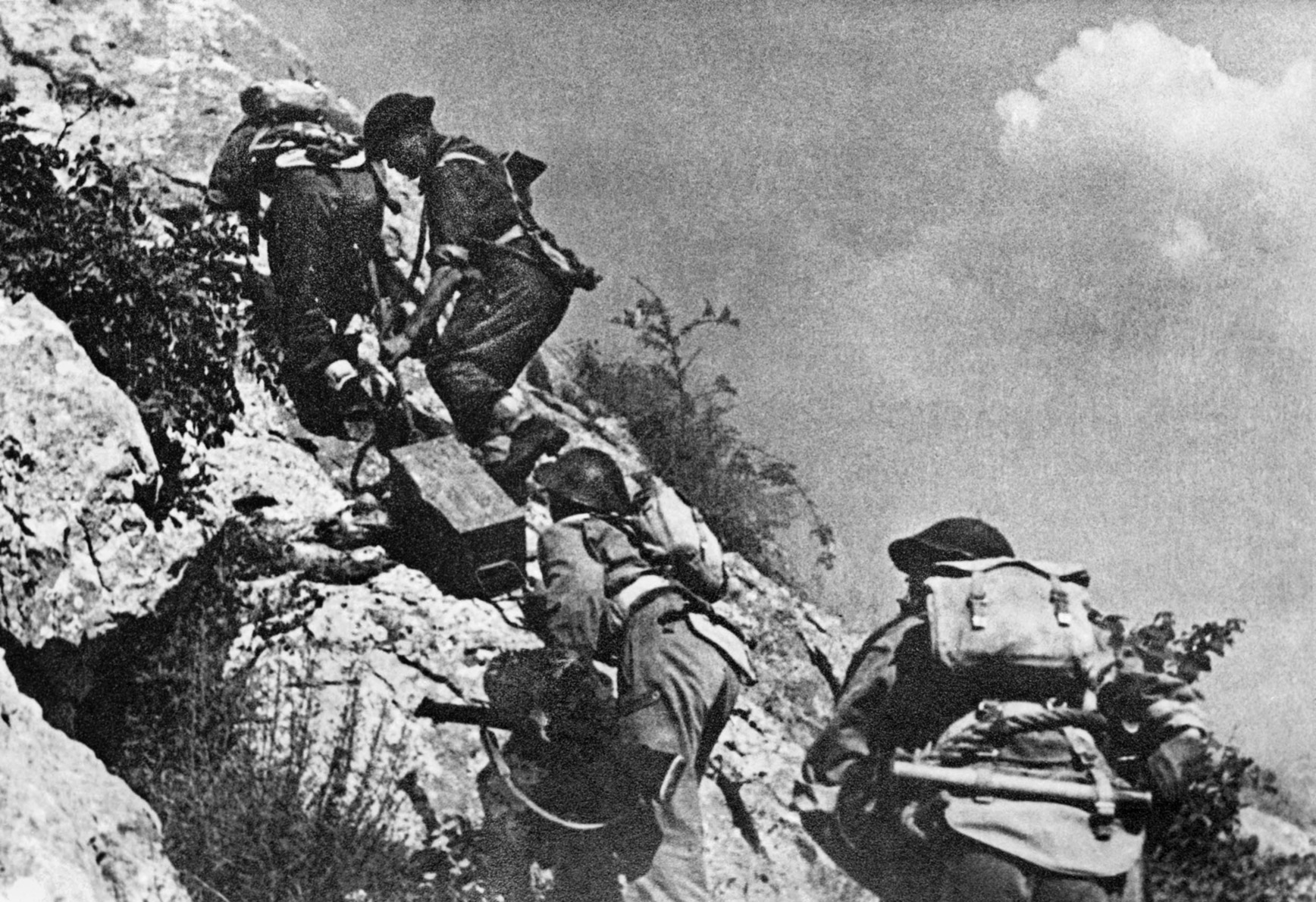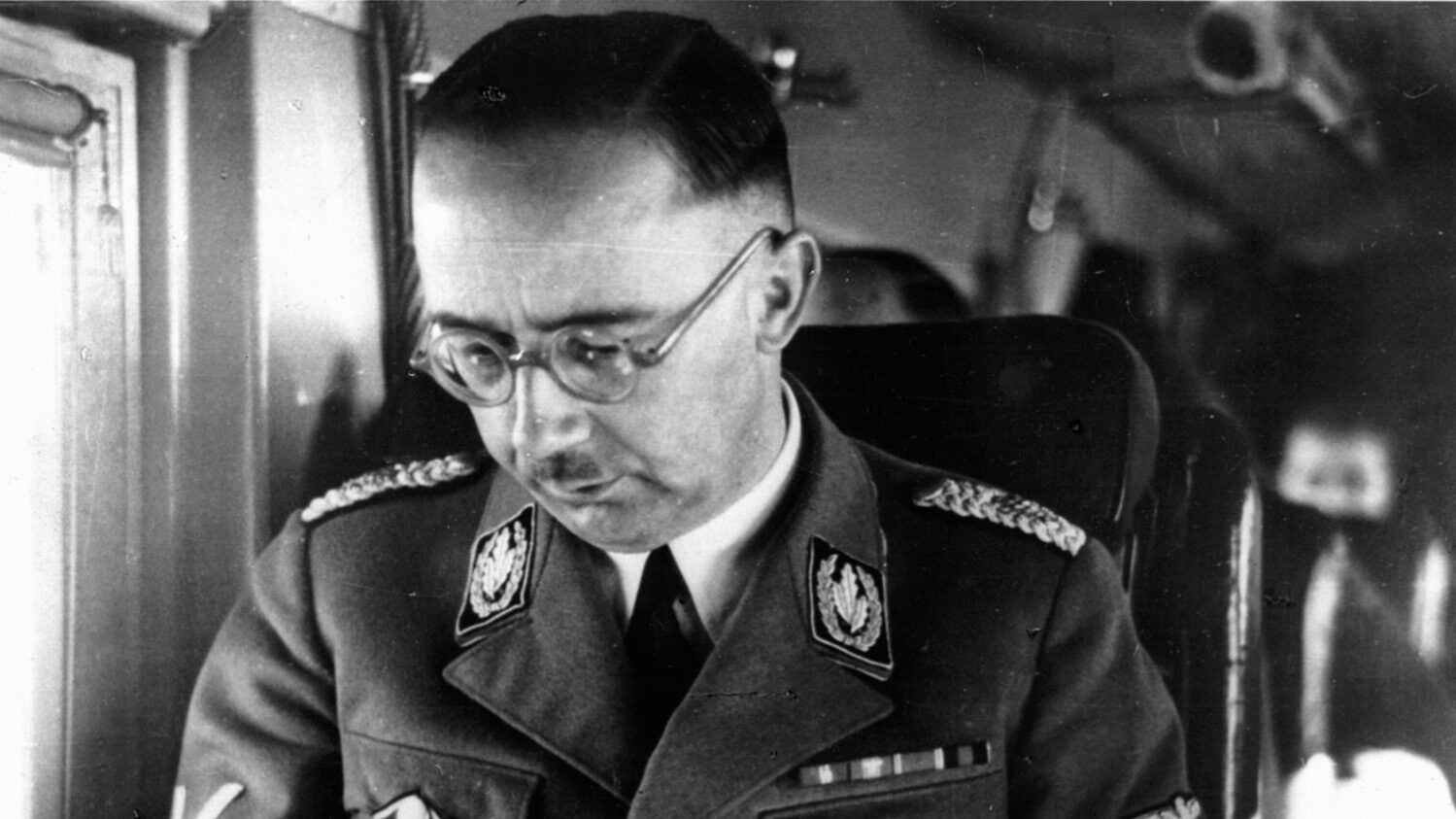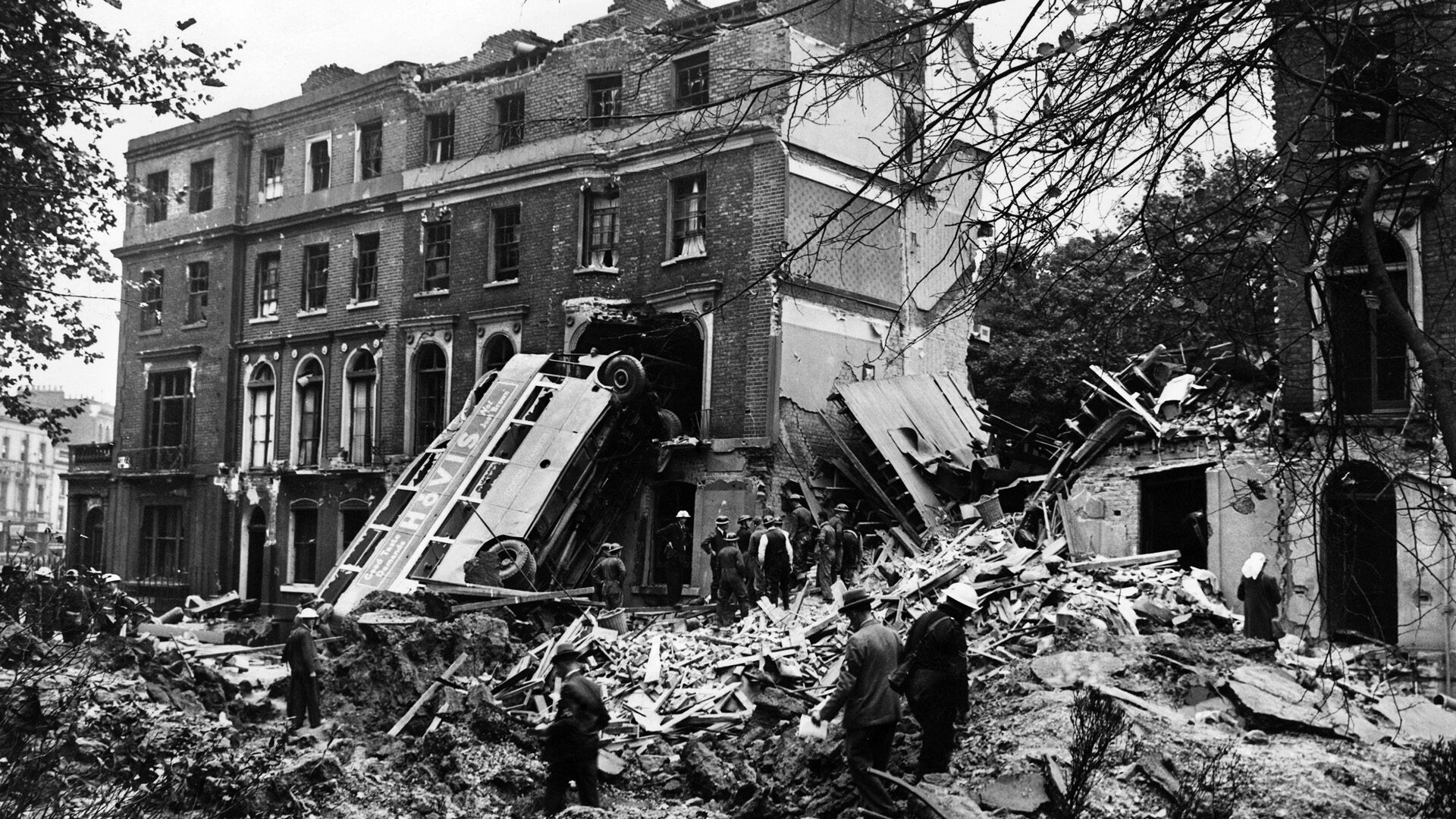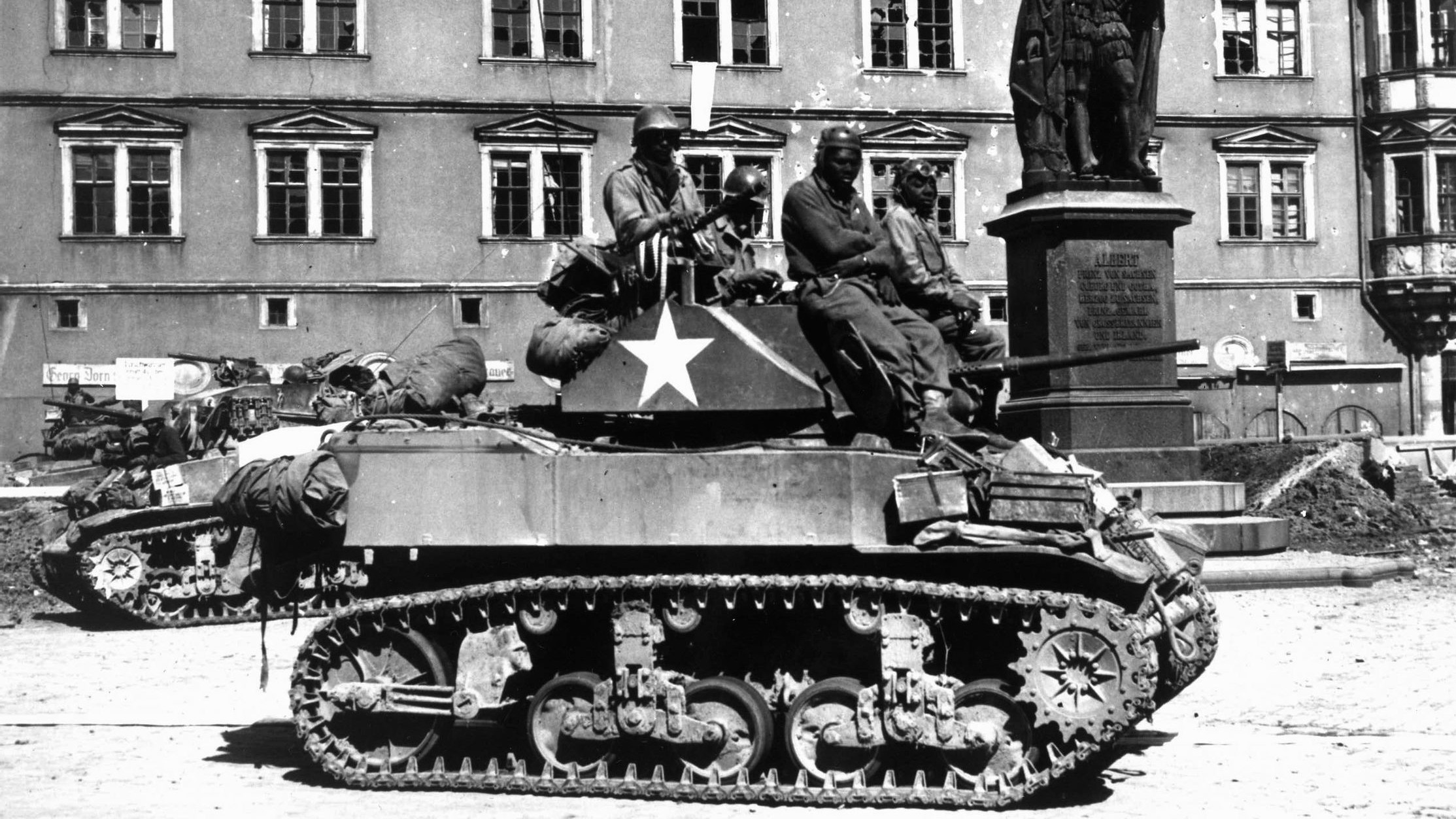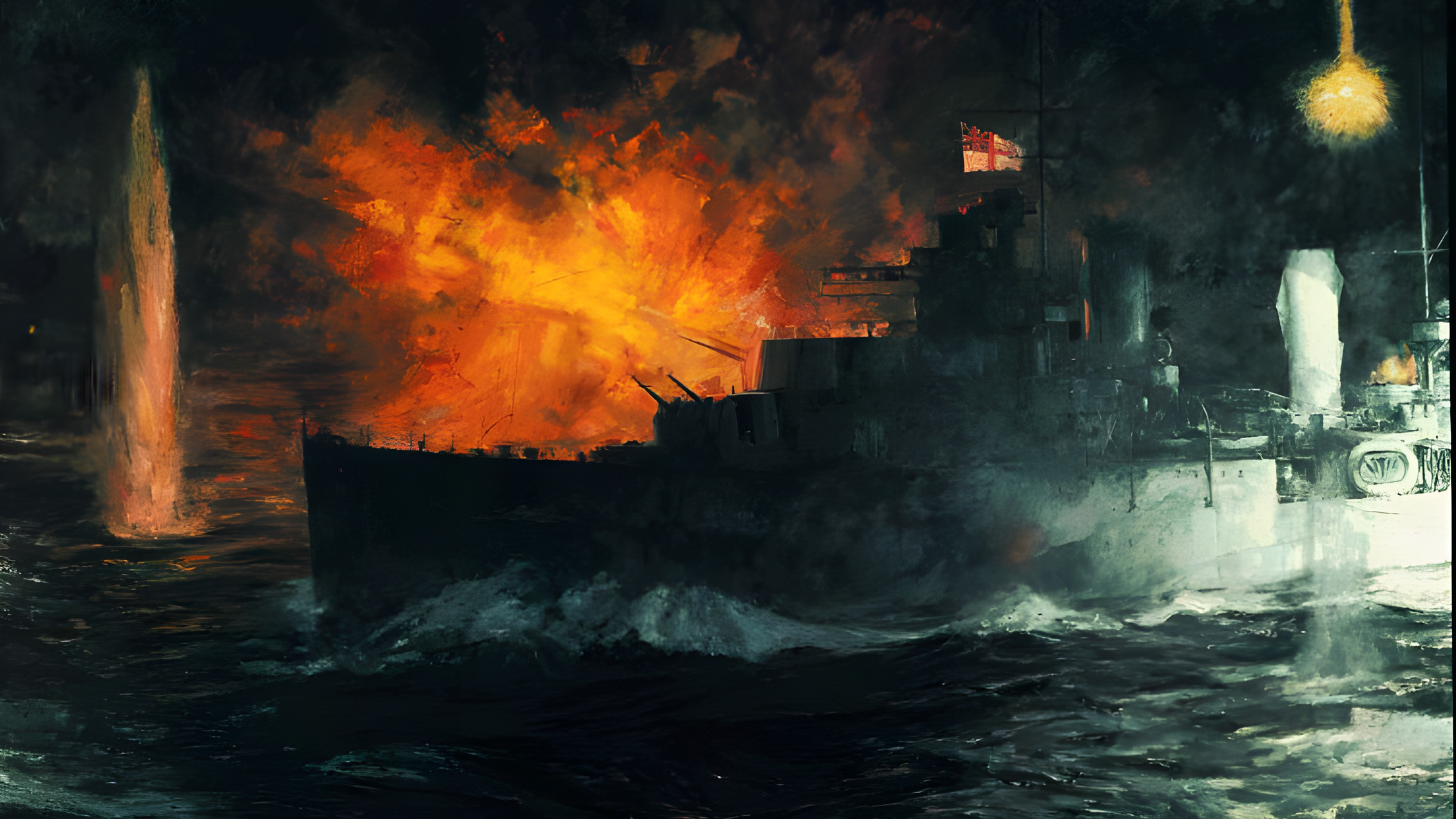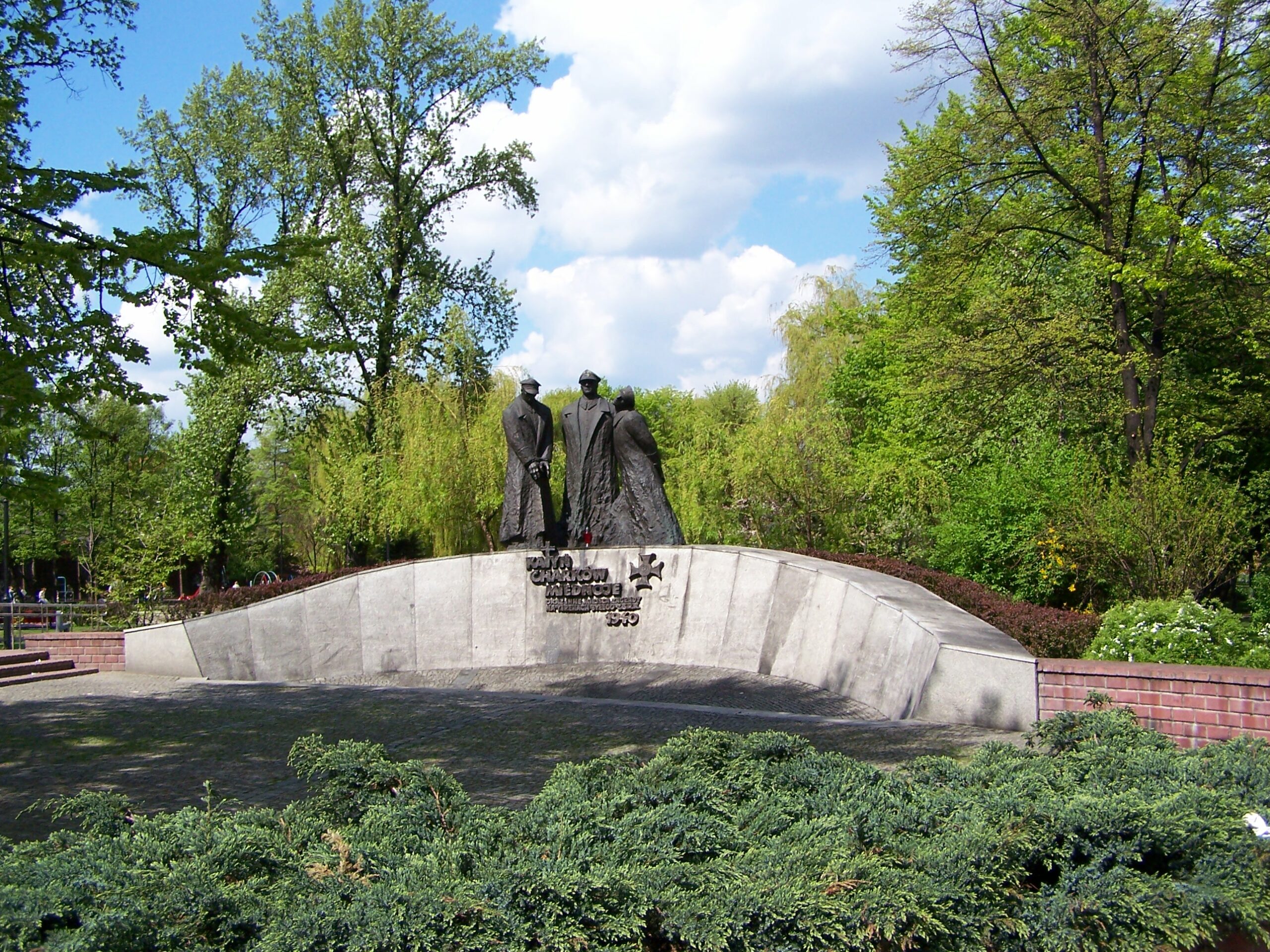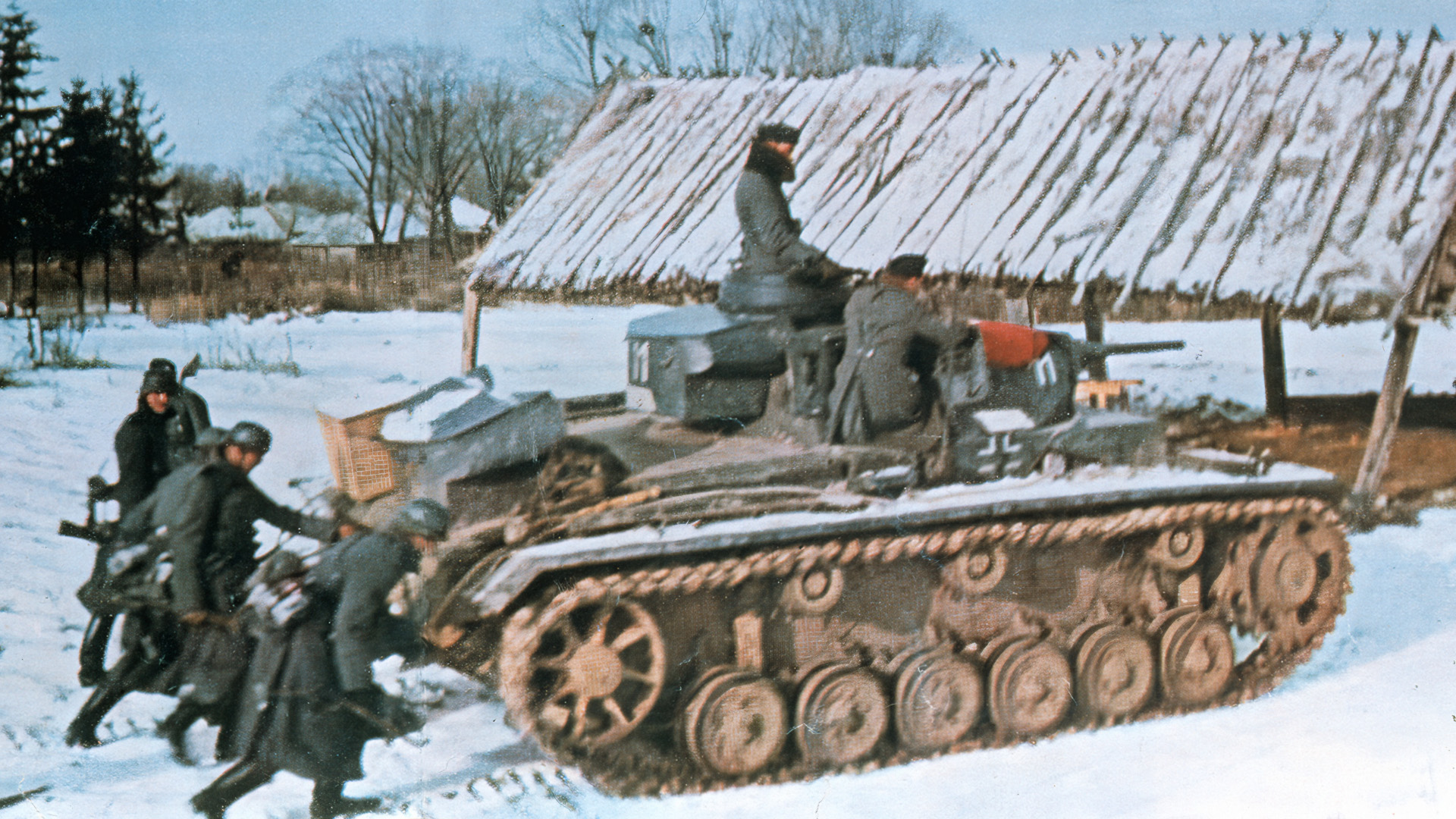By Mason B. Webb
Imagine that you are an Allied soldier in the ETO. You are in your foxhole on the front line, looking and listening for any sign that the Germans are about to attack your position.
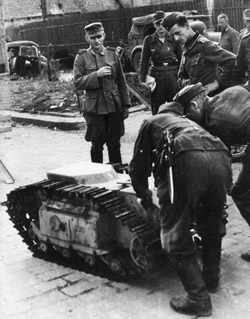
Then you see it—a small, funny-looking tracked vehicle heading your way. It looks like a toy—a miniature tank without a turret or a gun. “What the hell is this?” you ask yourself. You call out to your buddy in the foxhole next to you and direct his attention to this little interloper. You might even smile and laugh a little at the contraption. But the next minute your laughter is cut short when it explodes, killing you.
You have just been killed by what the Germans called the Leichter Ladungsträger Goliath—a remote-controlled tracked device packed with up to 220 pounds of explosive. Based on a French design, the Goliath was the product of the Carl F.W. Borgward automobile company of Bremen, Germany.
The vehicle was steered remotely by a joystick control box that was connected to the Goliath by a 2,130-foot-long, triple-strand cable attached to the rear of the vehicle, which was also used for transmitting power to the electric driven version (a later model was powered by a gasoline engine). Two of the strands were used to control the Goliath, while the third was used to detonate it.
The Goliath was just one of a host of unusual, exotic Wunderwaffe, or “Wonder Weapons,” that Hitler’s scientists and engineers devised before and during the course of World War II. In many respects Germany was far and away the most technologically advanced combatant nation, and her opponents worked hard to try and catch up; some never did.
Aircraft
One area in which Germany excelled was aircraft. The world’s first true jet––the single-engine Heinkel He-178––took to the air in August 1939, one week before Germany invaded Poland. The German Air Ministry was not impressed by the prototype’s performance, however, and the program was ended. This was followed by the He-280, which first flew in March 1941, but also never gained the Luftwaffe’s acceptance; only nine He-280s were built before the contract was cancelled.

But it is probably the Messerschmitt Me-262 A-1a Schwalbe (“Swallow”) that most people today regard as the world’s first successful jet fighter. Small by the standards of today’s fighters (length less than 35 feet, wingspan 41 feet), the Schwalbe had a range of 650 miles, a ceiling of 37,500 feet, and a maximum speed of 541 miles per hour. (In comparison, the North American P-51D Mustang powered by the Rolls-Royce Merlin engine had a range of 950 miles, a ceiling of 41,900 feet, and a top speed of 437 mph, Nearly 8,000 of the P-51D model were produced.)
Powered by two Junkers Jumo 004B-1 turbojet engines, the Schwalbe could zoom through American bomber formations, blasting the bombers with its four 30mm Mk 108 cannons and R4M rockets and departing before the pilots and aerial gunners knew what hit them.
But production problems plagued the Me-262 program. The scarcity of special high-temperature resistant alloys required by the engines was a major problem, as were the continual changes in design—and interference and changes in operational philosophy by German government and military officials who could not make up their minds as to whether the aircraft should be strictly a fighter or a fighter-bomber. A fighter bomber variant, the Me-262 A-2a Sturmvogel (“Stormbird”), was developed at Hitler’s insistence.
The first Schwalbe prototype flew on April 18, 1941, with a nose-mounted piston engine powering a propeller. As both jet engines failed during the test, it was fortunate that the pilot had an alternate power source to bring the plane safely back to earth. It was not until July 18, 1942, that Prototype V3 flew and satisfied all the requirements placed upon the program. The test flight preceded the introduction of Britain’s jet fighter, the Gloster Meteor, by nine months.
But the small number of trained jet pilots (a few hundred), fighters produced (1,400, with only less than 250 ever arriving at front-line squadrons due to shortages of pilots, jet fuel, and spare parts), and their limited flight time (about 60 minutes) made the jets’ contribution to Germany’s war effort less than the game-changer that Hitler hoped they would be. The Luftwaffe claimed 509 Allied aircraft downed at a cost of about 100 Me-262s—nearly half the planes sent up to stop the bombers.
After the war, the Allies, having captured hundreds of 262s, reverse engineered them and used many of the ideas in the development of the Lockheed P-80 Shooting Star, North American F-86 Sabre jet, and the Soviet MiG-15.
Other German aircraft that never got far beyond the drawing board were the Messerschmitt Me-329 Zerstorer heavy fighter; the Gotha Go P.60A day fighter/interceptor “flying wing;” the stubby, swept-wing, tailless Blohm und Voss Bv P.210 fighter bomber; the Focke-Wulf Triebflügel vertical takeoff and landing (VTOL) fighter, and the company’s Ta 283 interceptor.
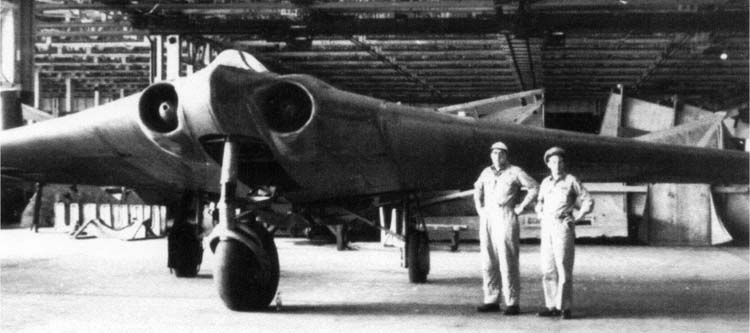
One exotic aircraft that was produced and made it to prototype stage was the Horten Ho-229 “flying wing” fighter-bomber. The Ho-229 was a response to Luftwaffe chief Hermann Göring’s call for a light, jet-powered bomber capable of carrying a payload of 2,200 tons. Only 20 of this radical plane were ever made—and a model under restoration can be seen today at the Steven F. Udvar-Hazy Center in Chantilly, Virginia.
Another aircraft at the same museum is the only surviving two-engine Arado Ar-234 B-2 “Blitz”—the world’s first jet-powered bomber—built in 1944.
Tanks
Germany arguably had the best armored fighting vehicles of World War II. The Panther tank, once it overcame its mechanical difficulties, was tough for American Shermans, British Churchills, and Soviet T-34s to beat on the battlefield. The 57-ton Tiger I tank (of which there were several models) was also a formidable opponent.
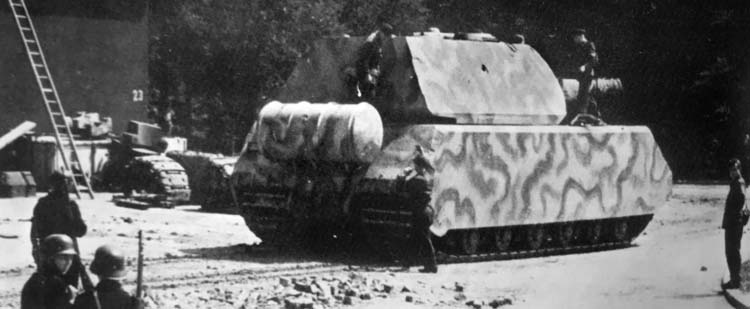
But instead of making more of the Tigers, the Germans went on to waste time and energy in designing a wide variety of tanks, tank killers, and self-propelled artillery that often were never produced. One example was the 188-ton Panzer VIII Maus, of which only two were built; both were captured by the Soviets.
Continuing to think that bigger would be better, the Germans went on to develop several super-heavy machines, such as the King Tiger (72.8 tons) and the 68-ton Porsche-created “Ferdinand” (later renamed “Elefant”) tank destroyer in 1943 with a powerful 88mm antitank gun. Three other tank destroyers—the “Rhinoceros” (12 tons), Jagdpanzer IV (27.6 tons), and Jagdtiger (35 tons), were mechanically unreliable, not to mention being manufactured in too few numbers. The StuG III was an excellent but heavy (26.8 tons) assault gun. The Sturmmorser 38 Self-Propelled Rocket Launcher weighed in at 72.8 tons. The largest class of self-propelled guns were the “Karls” (123 tons).
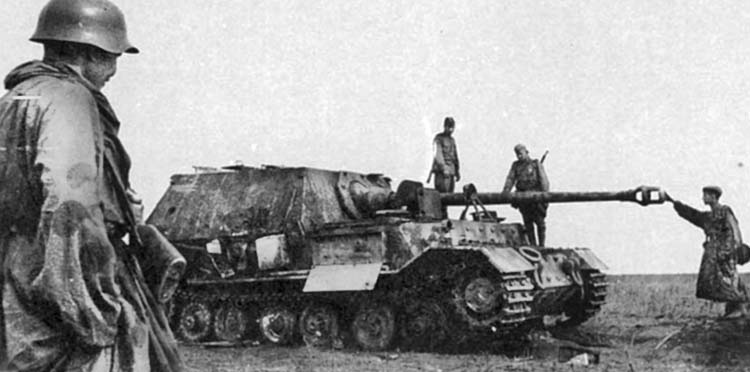
Several vehicles never made it from the drawing board to the battlefield. These included the Landkreuzer P.1000 “Ratte” (1,000 tons) and Landkreuzer P.1500 “Monster” (1,500 tons).
The Germans discovered, however, that the enormous weight of all these vehicles put a tremendous strain on the engines, transmissions, and suspension systems—not to mention their unquenchable thirst for increasingly scarce fuel—causing fatal breakdowns in combat. Often too heavy to move long distances under their own power, these behemoths had to be transported on reinforced railcars—and were thus at the mercy of Allied air power.
Missilery
The Germans were experimenting with other types of airborne weapons, specifically the V1 and V2 rockets. The V1 flying bomb—whose official name was the Fieseler FZG-76 Vergeltungswaffe 1 (Vengeance Weapon 1) but was nicknamed the “buzz bomb” and “doodlebug” by the Allies and the Kirschkern (Cherrystone) or Maikäfer (Maybug) by the Germans—was developed in 1941 by Robert Lisserr.
Relying on a liquid-fueled, pulse-jet engine, thousands of 29-foot-long V1s, carrying 2,000 pounds of explosives, were launched against southern England beginning on June 12, 1943, from sites in northern Europe. There were an average of 190 launches per day, or more than 10,000 in total.
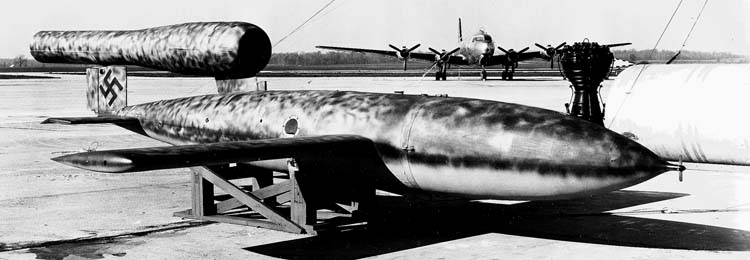
Although the missile traveled at a maximum speed of 340-400 mph, it was relatively vulnerable to antiaircraft fire and could also be intercepted and shot down by British Spitfires. Another anti-V1 technique was devised––flying alongside the V1 and flipping it over with a wingtip.
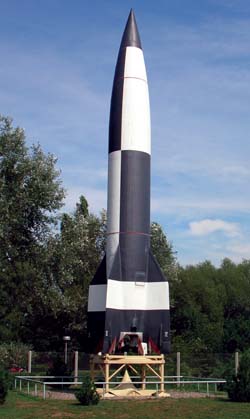
A far more formidable weapon against which there was no defense was the V2 (Vergeltungswaffe 2, or Vengeance Weapon 2), which was the brainchild of Wernher von Braun. The V2 production took place at a secret laboratory in Peenemünde until an air raid by the Royal Air Force destroyed most of it on August 17-18, 1943 (Operation Hydra). Production was switched to a factory inside a mountain near Nordhausen; both plants used thousands of concentration camp prisoners as workers.
Beginning in September 1944, the Germans sent over 1,760 V2s toward a variety of targets. Although wildly inaccurate, the V1s and V2s were effective at terrorizing the civilian populations in cities such as Antwerp (against which nearly 12,000 V1s were fired), Belgium, and London.
After the war, the United States and the Soviet Union scooped up as many German rocket scientists as they could find in order to begin developing their own ballistic missile and space programs. Despite his less-than-honorable past (i.e., the use of slave laborers in the V2 factories where thousands died), von Braun was brought to the United States and headed government programs to create missile systems. He was also the driving force behind the American space program that put a man on the moon in 1969.
Long-Range Artillery
During World War I, the Germans were preeminent in the development of especially powerful pieces of artillery. The first was dubbed “Big Bertha” (in German, Dicke Bertha, or “Fat Bertha”)—a 420mm (16.5 inch) Krupp-manufactured howitzer capable of firing a 1,785-pound shell designed to penetrate the thick concrete of French and Belgian forts. The gun and its carriage weighed about 47 tons and were serviced by a crew of 240 men. An even larger gun, with a caliber of 520mm, was also developed.
The other weapons were known as the Paris Guns, with their 112-foot-long barrels. While the Big Berthas had a range of only six miles, the 240mm Paris Guns, also built by Krupp and transported on railroad carriages, could fire a shell a then-unheard-of distance of 75 miles. Both the Big Berthas and the Paris Guns were extremely successful in fulfilling their roles.
When World War II broke out, the Germans again looked to large-caliber, long-range artillery pieces. Two 11-inch K5 railroad guns dubbed “Anzio Annie” and the “Anzio Express” by the Allies (and “Robert” and “Leopold” by the Germans) were hauled to Italy and used to bombard Allied forces pinned down on the Anzio beachhead from January to May 1944. Similar guns were emplaced in France along the English Channel to shell southern England.
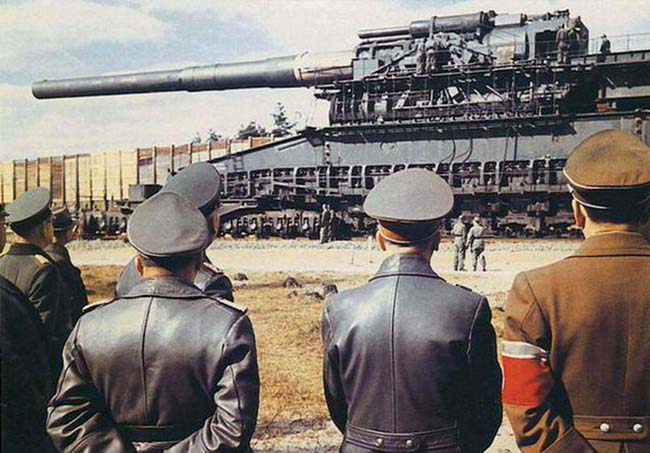
The Germans also installed at a secret location at Mimoyecques along the upper Normandy coast near the Pas de Calais a Krupp “super gun” called the V3 cannon or London Gun. Its purpose was to shell London and its environs with 300 shells per hour. It operated on a multi-charge principle whereby, once the 310-pound shell was fired, a series of solid-fuel secondary propellant charges placed in symmetrical pairs along its 300-foot-long barrel would give it an extra boost to achieve a range of just over 100 miles. Construction began in September 1943.
Built inside a hill with miles of support tunnels, the London Gun––fortunately for the British––never became operational; on July 6, 1944, Lancaster bombers of RAF 617 Squadron, the famous “Dambusters,” knocked it out using 12,000-pound “Tallboy” deep-penetration bombs.
Some sources say that the U.S. Navy also got in on the act in August and decided to hit the site with a drone version of the B-24 Liberator bomber loaded with 21,170 pounds of Torpex explosives. One of the two pilots aboard the B-24 was Joseph P. Kennedy, Jr.—the son of the former U.S. ambassador to Britain and the older brother of future President John F. Kennedy. The plan was for the American airmen to take off in the bomber and then bail out; it would then be remotely guided to its target by a following plane.
But a malfunction occurred shortly after takeoff and the plane exploded over Blythburgh, England, killing both Kennedy and the other pilot, Wilford J. Willy. Other sources say that the target was either a V2 launching site or U-boat pens at Heligoland in the North Sea.
Today tours are offered at the Mimoyecques site.
Two other V3s were installed at Hermeskeil-Lampaden, near Trier, Germany, in order to bombard Luxembourg City—27 miles away—which had been liberated by the Allies in September 1944. A total of 190 rounds were fired before the site was abandoned on February 22, 1945, as U.S. Army units closed in.
Atomic Bomb
No doubt the most formidable of all the German wonder weapon projects would have been an atomic bomb.
In January 1939, two German chemists, Otto Hahn and Fritz Strassmann, published the results of their experiment in which they were able to split the uranium nucleus—a feat that touched off a frenzy of scientific work on fission around the world. That autumn, the German “uranium project” was given the green light by Hitler’s regime.
German Army Ordnance then established a research program led by physicist Kurt Diebner to investigate the possible military applications of fission. By the end of 1939, physicist Werner Heisenberg determined that achieving a nuclear fission chain reaction was possible. According to one historian, “When slowed down and controlled in a ‘uranium machine’ (nuclear reactor), these chain reactions could generate energy; when uncontrolled, they would be a ‘nuclear explosive’ many times more powerful than conventional explosives.”
Heisenberg and a colleague, Carl Fried-rich Weizsäcker, began using rare uranium 235 as an explosive. After reading various international scientific journals, the two concluded that, if a nuclear reactor could sustain a chain reaction, some of the more common uranium 238 would be converted into “element 94,” or plutonium. Work went ahead in developing the complex techniques required to create the amount of fissionable material needed to create a weapon.
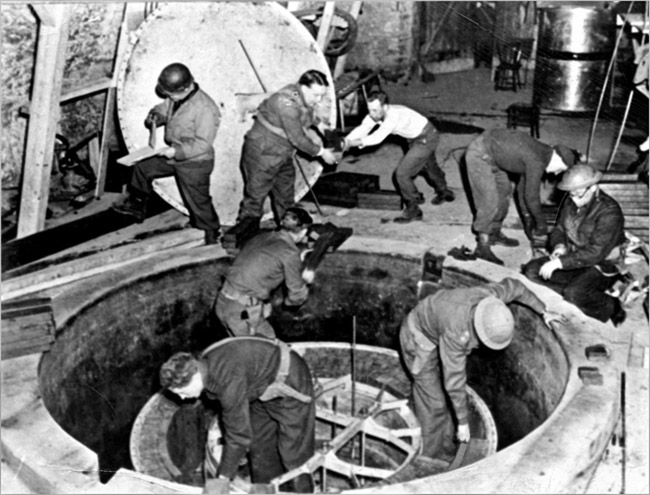
One of the components the scientists focused on was “heavy water” (deuterium oxide), which was then being manufactured by the Norsk Hydro plant in Nazi-occupied Norway. When the American and British Allies (who were already well along in their own joint program to build a nuclear weapon) learned what the Germans were up to, they employed Norwegian resistance members to sabotage the Norsk Hydro plant. Their heroic efforts were dramatized in the 1965 Hollywood film, The Heroes of Telemark.
The German a-bomb project failed for several reasons. One, the Nazi government, under increasing pressure from the Allied aerial bombing program and losses on the battlefield, could not devote the tremendous financial resources necessary to build a practical bomb.
Two, many of the top physicists—such as Albert Einstein, Edward Teller, Otto R. Frisch, Hans Bethe, Rudolf E. Peierls, John von Neumann, and the turncoat Klaus Fuchs—escaped from Germany, Austria, and other Eastern European countries in the 1930s and took their knowledge to the U.S., thus giving a boost to the American and British atomic bomb program known as the Manhattan Project.
And, three, men such as Heisenberg and his colleagues may have realized the awesome destructive potential of the project on which they were working and made a conscious (or unconscious) decision to not put their maximum effort into helping their homeland win the war.
Although Nazi Germany was far ahead of the U.S., Britain, and the Soviet Union in terms of creating technologically advanced weapons of war, in the end those weapons failed to give Hitler the edge he needed to defeat his enemies.
Perhaps, given more time, the Nazis could have prevailed. But, thankfully for civilization, that is a “what if” that has no answer.
